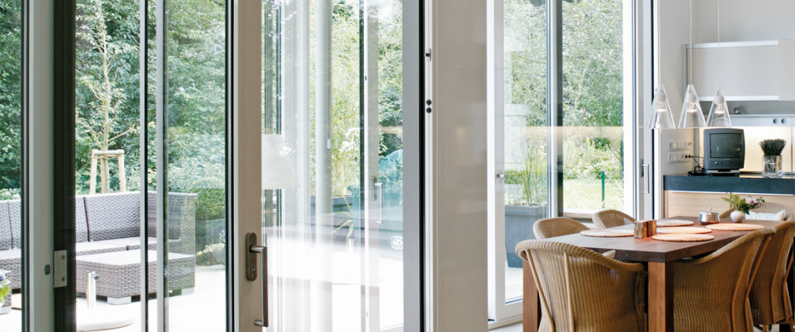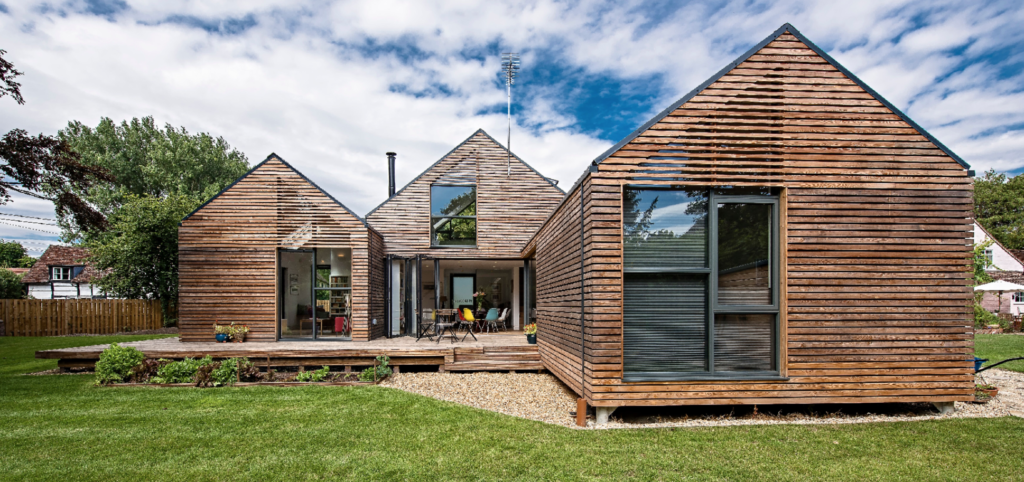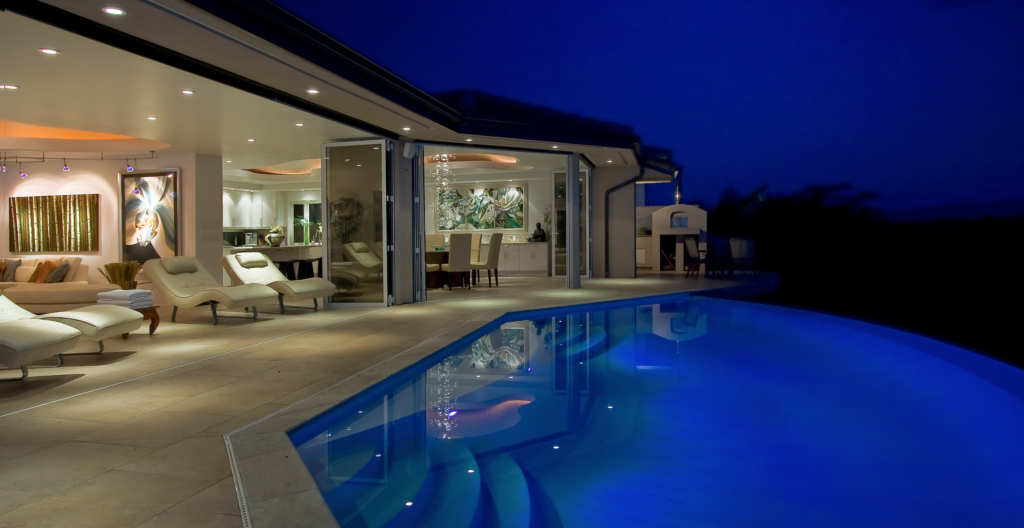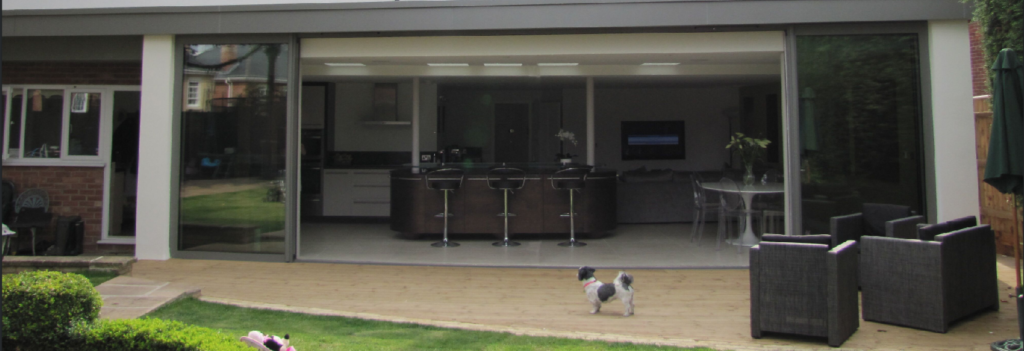What are bifold doors and how do they work?
Bifold doors make a brilliant alternative to traditional French doors or sliding doors. They’re becoming increasingly popular thanks to their chic style and space-saving functionality, but many people still ask “what are bifold doors and what are the benefits of them?” Let’s take a look at the pros and cons of bifold doors and establish what makes them different.
How bifold doors work
If you want to know how bifold doors work, simply think of a concertina effect. Essentially, bifold doors are made up of multiple leaves which fold back on themselves in order to open up an entire aperture.
The doors are fitted to runners, and when opened they slide and fold at the same time for seamless operation. This means that you don’t have to make as much space for the door to swing open like normal hinged doors or French doors. However, it also means that you don’t have to settle for a smaller entranceway like with traditional sliding doors.
Depending on the configuration chosen, many bifold doors feature what is known as a “traffic” door. Essentially, this is a conventional door built into the bifold system, which sits on a normal hinge and has a standard lever handle. This allows for quick and easy access through the entranceway when you don’t want to fold and slide open every single leaf in the bifold. This is particularly useful for busy entranceways which you tend to use regularly.

What is a sliding door and how does it differ from bifold doors?
There is often confusion around the difference between sliding doors and bifold doors, because bifold doors require runners and sliding is an important part of their function. Standard sliding doors, however, do not fold. Essentially, they are made up of two leaves, and only one of the leaves moves.
The moving leaf slides in front of the stationary leaf. Sliding doors therefore result in half of the aperture being permanently blocked. However, the benefit of them is that door does not at all impede on the living space or exterior space around it when opened.
Because bifold doors slide and fold at the same time, it is possible to open up almost the entire aperture. Although a small amount of space is taken up by the folded leaves when open, it is far less than with normal hinged doors.
Essentially, bifold doors are a hybrid of sliding doors and traditional French or patio doors, and they offer the best of both worlds in terms of space-saving ability.
How bifold doors work as exterior doors
Bifold doors are wonderful for exterior doors because they allow you to easily open up the barrier between your indoor and outdoor space. This is perfect for summer entertaining and al fresco dining, or simply for keeping an eye and ear on the kids when they’re playing in the garden. Since the doors don’t take up too much space either inside or out when they’re open, they’re great for confined living spaces or gardens.

Installing internal bifold doors
Bifold doors are a wonderful solution for those who want a flexible, open plan interior space. They can completely separate two individual rooms, offering better insulation and soundproofing when closed, and can then be folded completely open when you need a larger space.
Installing a full expanse of glass doors in a room can also allow you to incorporate more natural light into rooms which have smaller windows or are simply a little too dark.
It’s not just residential properties that can benefit from these features, though; internal bifold doors are ideal for modern commercial properties who need flexible office, meeting, or event spaces.
You could choose a bifold door manufacturer which offers integrated blinds with their doors, too, so that when you do need to divide an area up into individual rooms, you can ensure the spaces remain completely private.
If you’re considering how to fit internal bifold doors, it’s best to consult an expert. There are different types of runners and thresholds available for internal doors which sit flush to the floor and prevent tripping. Seeking out a consultation will allow you to see what your options are and choose a configuration that perfectly suits your living space.
What size bifold doors are available?
One of the brilliant things about how bifold doors work is that they are suitable for both small and large apertures. There is a great deal of variation in leaf size – we offer standard leaf sizes between 400mm and 1200mm wide, which makes it possible to create a bifold door configuration for a huge range of entranceways. You can also have a relatively high number of leaves if you’re aiming to create a vast, glass wall which can be completely opened up to your outdoor space.

Pros and cons of bifold doors
The biggest pro of bifold doors is that they can allow almost the entire entranceway – around 90% – to be opened up. Plus, they’re perfect for large entranceways in which traditional French doors would be too small.
They also don’t require quite as much space around them as French doors since they don’t need to be swung open, but you do need a little area of clear space to allow the leaves to stack up when the doors open, which is a small con.
In situations where you really don’t want your living or outdoor space to be encroached upon when the doors are open, sliding doors may be a more suitable option. However, sliding doors will block an entire section of the aperture, which is unappealing if you love the idea of totally opening up the entranceway to your home.
One of the best folding door advantages is that they can help to bring the outdoors in and create a sense of open plan living that sliding doors simply cannot replicate.
Another benefit of bifold doors is that they offer a lot of flexibility in terms of configuration. You can choose the number of leaves, the size of each leaf, the direction of opening, and the inclusion of a traffic door. Plus, particularly if you opt for aluminium doors, you have a wide variety of colours and finishes to select from, too. This level of choice allows you to create a bespoke entranceway that would be a little harder to achieve with sliding doors or French doors.
When considering bifold doors which way to open is a major decision. The doors can either open inwards, in which case they’ll take up a small amount of space inside the aperture, or outwards, in which case they’ll take up space outside. Ultimately, your decision will depend on the space you have available inside or out. If you have a small garden or patio area, inside opening may be favourable. However, if you have lots of furniture positioned close to the doors inside your home, outside opening will likely be the better choice. While traditional French or patio doors can offer a choice of inside or outside opening, the amount of free space needed to enable opening the doors is much larger than with bifold doors.
Lots of people find that they simply don’t have the interior space available for inside opening French doors. With bifold doors, many find it easier to make the small amount of interior space available for inside opening. Having more choice when deciding which way your doors open to is definitely a pro.

Many people think that bifold doors are much more expensive than sliding doors or French doors, and they look at this as a major con. It is true that bifold doors can cost more than the other alternatives, simply because they are more complex and require additional manufacturing.
However, if you’re already considering aluminium sliding doors due to their durability and long lifespan, you may be surprised to learn that there may be little difference in cost between sliding and bifold aluminium doors. In fact, sliding aluminium doors may be more expensive than aluminium bifold systems.
What do bifold doors cost?
So, what do bifold doors cost? That entirely depends on the manufacturer you choose, the size of the aperture, and the style of door you’re looking for. Aluminium bifold doors tend to be more expensive than uPVC, but their durability can offer a much longer lifespan which can make them the more cost-effective choice in the long run.
You can also expect to pay a little more for doors which provide superior thermal insulation and security features. The best way to find out how much bifold doors will cost is to arrange a consultation with a manufacturer or installer. They will measure up your aperture, discuss your requirements, style preferences and budget, and provide you with a bespoke quote.
If you’d like to further discuss how bifold doors work and if they’re practical for your home, please do not hesitate to get in touch and discuss your options with one of our experts. We can help you to decide whether bifold doors are suitable for your home, and run through the various configurations and design choices available to help you come to the right decision.
